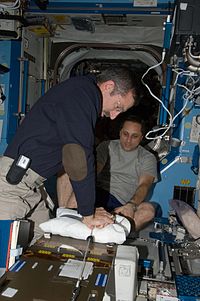
Photo from wikipedia
On Earth, humans are subjected to a gravitational force that has been an important determinant in human evolution and function. During spaceflight, astronauts are subjected to several hazards including a… Click to show full abstract
On Earth, humans are subjected to a gravitational force that has been an important determinant in human evolution and function. During spaceflight, astronauts are subjected to several hazards including a prolonged state of microgravity that induces a myriad of physiological adaptations leading to orthostatic intolerance. This review summarises all known cardiovascular diseases related to human spaceflight and focusses on the cardiovascular changes related to human spaceflight (in vivo) as well as cellular and molecular changes (in vitro). Upon entering microgravity, cephalad fluid shift occurs and increases the stroke volume (35–46%) and cardiac output (18–41%). Despite this increase, astronauts enter a state of hypovolemia (10–15% decrease in blood volume). The absence of orthostatic pressure and a decrease in arterial pressures reduces the workload of the heart and is believed to be the underlying mechanism for the development of cardiac atrophy in space. Cellular and molecular changes include altered cell shape and endothelial dysfunction through suppressed cellular proliferation as well as increased cell apoptosis and oxidative stress. Human spaceflight is associated with several cardiovascular risk factors. Through the use of microgravity platforms, multiple physiological changes can be studied and stimulate the development of appropriate tools and countermeasures for future human spaceflight missions in low Earth orbit and beyond.
Journal Title: Biomedicines
Year Published: 2021
Link to full text (if available)
Share on Social Media: Sign Up to like & get
recommendations!